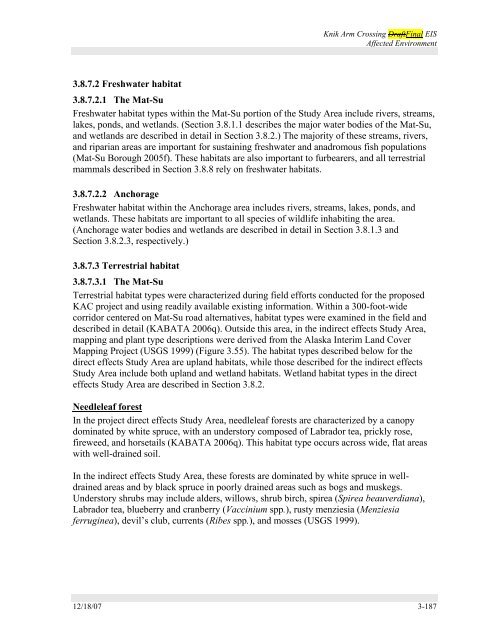3.0 Affected Environment - Knik Arm Bridge and Toll Authority
3.0 Affected Environment - Knik Arm Bridge and Toll Authority
3.0 Affected Environment - Knik Arm Bridge and Toll Authority
Create successful ePaper yourself
Turn your PDF publications into a flip-book with our unique Google optimized e-Paper software.
<strong>Knik</strong> <strong>Arm</strong> Crossing DraftFinal EIS<br />
<strong>Affected</strong> <strong>Environment</strong><br />
3.8.7.2 Freshwater habitat<br />
3.8.7.2.1 The Mat-Su<br />
Freshwater habitat types within the Mat-Su portion of the Study Area include rivers, streams,<br />
lakes, ponds, <strong>and</strong> wetl<strong>and</strong>s. (Section 3.8.1.1 describes the major water bodies of the Mat-Su,<br />
<strong>and</strong> wetl<strong>and</strong>s are described in detail in Section 3.8.2.) The majority of these streams, rivers,<br />
<strong>and</strong> riparian areas are important for sustaining freshwater <strong>and</strong> anadromous fish populations<br />
(Mat-Su Borough 2005f). These habitats are also important to furbearers, <strong>and</strong> all terrestrial<br />
mammals described in Section 3.8.8 rely on freshwater habitats.<br />
3.8.7.2.2 Anchorage<br />
Freshwater habitat within the Anchorage area includes rivers, streams, lakes, ponds, <strong>and</strong><br />
wetl<strong>and</strong>s. These habitats are important to all species of wildlife inhabiting the area.<br />
(Anchorage water bodies <strong>and</strong> wetl<strong>and</strong>s are described in detail in Section 3.8.1.3 <strong>and</strong><br />
Section 3.8.2.3, respectively.)<br />
3.8.7.3 Terrestrial habitat<br />
3.8.7.3.1 The Mat-Su<br />
Terrestrial habitat types were characterized during field efforts conducted for the proposed<br />
KAC project <strong>and</strong> using readily available existing information. Within a 300-foot-wide<br />
corridor centered on Mat-Su road alternatives, habitat types were examined in the field <strong>and</strong><br />
described in detail (KABATA 2006q). Outside this area, in the indirect effects Study Area,<br />
mapping <strong>and</strong> plant type descriptions were derived from the Alaska Interim L<strong>and</strong> Cover<br />
Mapping Project (USGS 1999) (Figure 3.55). The habitat types described below for the<br />
direct effects Study Area are upl<strong>and</strong> habitats, while those described for the indirect effects<br />
Study Area include both upl<strong>and</strong> <strong>and</strong> wetl<strong>and</strong> habitats. Wetl<strong>and</strong> habitat types in the direct<br />
effects Study Area are described in Section 3.8.2.<br />
Needleleaf forest<br />
In the project direct effects Study Area, needleleaf forests are characterized by a canopy<br />
dominated by white spruce, with an understory composed of Labrador tea, prickly rose,<br />
fireweed, <strong>and</strong> horsetails (KABATA 2006q). This habitat type occurs across wide, flat areas<br />
with well-drained soil.<br />
In the indirect effects Study Area, these forests are dominated by white spruce in welldrained<br />
areas <strong>and</strong> by black spruce in poorly drained areas such as bogs <strong>and</strong> muskegs.<br />
Understory shrubs may include alders, willows, shrub birch, spirea (Spirea beauverdiana),<br />
Labrador tea, blueberry <strong>and</strong> cranberry (Vaccinium spp.), rusty menziesia (Menziesia<br />
ferruginea), devil’s club, currents (Ribes spp.), <strong>and</strong> mosses (USGS 1999).<br />
12/18/07 3-187
















